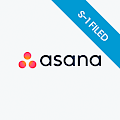Off the heels of major tech companies taking the DPO route for their public listings (i.e. Slack and Spotify), two more direct listings hit the public markets in September and made waves. Palantir and Asana both made their public debuts the last week of September, and both decided to go with a direct listing or DPO.
Direct listings offer reduced hype cycles, less volatility, cost-effective methods that cut out underwriters, and usually, the ability to avoid lockups. They benefit shareholders and employees overall, but performance has been mixed, and many are curious about how DPOs fare against their IPO counterparts.
When Palantir filed its S1, it was a significant moment for its employees, shareholders and for everyone who was awaiting the tech giant’s public debut for 17 years. Palantir’s debut was also a major moment for the private markets given the trading of the tech giant’s shares were an early indication of the insights one could potentially glean from a marketplace like Forge. In the case of Palantir’s direct listing, the reference price was squarely in the middle of what investors in the private markets were paying for the stock in the lead up to the debut. This was an indication that the price of the stock was set at not only an expected value but one that represented the reality of what it was worth. By the end of day-one trading, Palantir closed within 10% of its reference price showing it was a fair value for the company and its investors.
Now, when we look at Asana, we saw a similarly anticipated Silicon Valley unicorn take the direct listing route for its public debut, with a reference price of $21 and an opening day price of $27. In the month leading up to Asana’s public debut, the company reported in its SEC filing that shares traded between $14.24 to $28 a share, with a volume-weighted average price of $25.11, right in the middle of it’s reference price and it’s opening day price – indicating a spot on value for its shareholders.
Before this year, the two previous monumental tech direct listings, Slack (in 2019) and Spotify (in 2018) both saw first-day gains and used a reference price method, based on where shares were trading in the secondary markets in the lead up to their public debut, to set their reference points. Slack, the online communications tool, soared 49% from its initial reference price of $26, which matched the pricing of the stock in the private markets, to close at $38.62. Online music provider, Spotify, which also used the reference price method, entered its debut day with a price reflective of the trading the stock experienced on the secondary market. In 2018, Spotify shares traded on the private markets between $90 and $132.50, informing the company's reference price of $132, before it hit its opening trade of $165.90 or a 25% increase.
When you look at these results and compare them to a recent tech software stock debut from Snowflake, there’s a clear juxtaposition in the delta of the reference price and the opening day price. As an IPO, Snowflake opened its public debut with a reference price of $120, and by the open of its first day of trading, it experienced a 104% surge up to $245, which may look like a great success, but actually indicates a missed opportunity in proper pricing. In the case of Snowflake, it was underpriced.
So which of these exits were successful? When it comes to direct listings and public debuts, what we’ve seen is that success should be defined by the value a stock provides its shareholders and a price that is well informed by data. Performance as indicated by private markets can drive that value, and by offering insights that companies should want to leverage, it can save them and their investors from a position where they may miss out because a stock is underpriced, as is the case with Snowflake, or truly drive a fair value for their shareholders, as exhibited by Palantir.
At Forge, we help companies and investors better understand trends and pricing so they can make decisions that benefit them.




